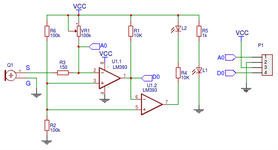zxcv2201
Member level 1
This is a circuit diagram of the sound detection sensor.
I know that when the signal goes in, D0 goes high, the output of the second comparator goes low, and LED2 turns on.
However, I don't really understand the operating principle.
First of all, here's what I thought:
When a sound occurs, the voltage entering A0 and the comparator input are divided into voltages. Therefore, I thought that if the variable resistance is large, A0 operates sensitively, and on the other hand, the signal entering the input of the comparator decreases, increasing the threshold value of the digital output.
I am not sure if the above interpretation is correct. If I'm wrong, I'd like to ask the following two questions.
1. I would like to know the principle of how A0 and D0 change as the variable resistance changes.
2. Ultimately, I would like to know how the threshold of the comparator is determined.
I know that when the signal goes in, D0 goes high, the output of the second comparator goes low, and LED2 turns on.
However, I don't really understand the operating principle.
First of all, here's what I thought:
When a sound occurs, the voltage entering A0 and the comparator input are divided into voltages. Therefore, I thought that if the variable resistance is large, A0 operates sensitively, and on the other hand, the signal entering the input of the comparator decreases, increasing the threshold value of the digital output.
I am not sure if the above interpretation is correct. If I'm wrong, I'd like to ask the following two questions.
1. I would like to know the principle of how A0 and D0 change as the variable resistance changes.
2. Ultimately, I would like to know how the threshold of the comparator is determined.
